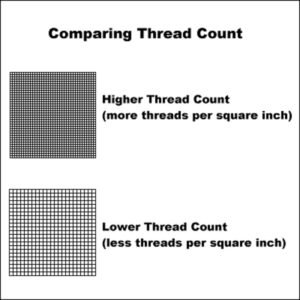If everything else is the same (weave, ply, mill, and type of cotton), higher thread count means a smoother, silkier, more expensive fabric. Thread count is often referred to with a number like the 50s, 80s, 100s, 120s, 140s, 170s, etc. up to 330s. These numbers refer to the yarn size, but keep in mind that typically a thread count above 100 will imply a 2-ply fabric. Though there are some exceptions when extremely fine single ply yarns are used, these higher number thread counts will be two yarns twisted together. For example, 120’s thread count means that two 60’s yarns are twisted together. Generally, this fabric will be more durable than a 60’s single ply, but it won’t necessarily be smoother. 140’s thread counts are typically two 70’s yarns twisted together. And so on While thread count can be an indicator of quality, remember that ply, mill, and quality of cotton will have just as much to do with how luxurious the fabric is.

Two Ply vs. Single Ply
Two Ply vs. Single Ply
Ply is what number of yarns are curved together to make a solitary string. Shirting textures are frequently two-ply or single ply. Two-ply implies that two yarns are turned together to make a solitary string that is then woven into the texture. Two-ply textures are commonly better than single-ply textures in their strength.
“Three-ply, four-ply textures are unique, however can be found occasionally.”

Twill
Twill textures are effectively unmistakable on the grounds that they will show a slanting weave or surface. The inclining impact can run from exceptionally fine, inconspicuous twill to a lot bigger Imperial or Cavalry twill. Twill will quite often have a touch of sparkle; however, the degree can rely upon the weave, shading, and cotton utilized. Twill is an amazingly tight weave that can come in very high-string tallies, some of which may be confused with silk. In view of the slanting surface, twill is somewhat gentler than broadcloth and will wrap all the more without any problem. Twill is moderately simple to iron and impervious to wrinkles.

Wool
A fall/ winter top choice, Woolen clothes are warm, fluffy textures that are regularly brushed twill or brushed poplin textures. While they’re most normally 100% cotton, they some of the time can come in cotton/fleece, and even cotton/cashmere mixes for included warmth. Normally made in thicker weaves, these are positively easygoing textures that are extraordinary for chilly climates.












Hello kashifnaseer.com admin, Keep it up!
InshAllah